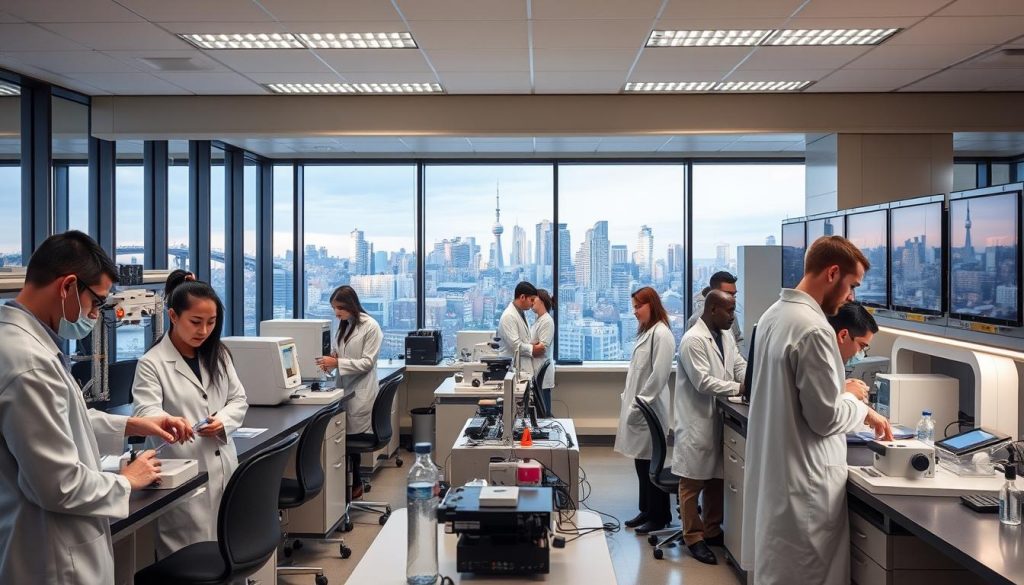One striking fact: UK-based teams won 18 ERC Synergy Grants this cycle, second only to Germany, showing early momentum after reassociation. This achievement not only reflects the resilience of UK researchers but also highlights the competitive spirit and innovative capacity that continues to thrive despite the challenges posed by Brexit. The ERC Synergy Grants are particularly significant as they encourage collaboration among teams from different institutions, fostering a collaborative research environment that can tackle complex scientific questions related to research innovation.
The government staged an advertising push and a series of roadshows to reconnect researchers with the Horizon Europe programme after post‑Brexit disruption. These initiatives were designed to inform and inspire researchers about the opportunities available through Horizon Europe, aiming to revitalise participation and investment in collaborative research projects that span multiple countries. By engaging directly with the research community, the government sought to rebuild trust and encourage more competitive bidding for funding in the fields of science and technology.
Peter Kyle met European commissioners in Brussels on 29 January to underline intent for collaboration on climate, public health and growth. This meeting was pivotal in reaffirming the UK’s commitment to working alongside European partners on pressing global challenges, demonstrating that despite the political landscape, the UK remains a key player in international research and innovation efforts, solidifying its position as a leader in R&D.
Innovate UK prepared delegations to Italy, Germany and Spain, while the British Academy offered pump‑priming grants to spark partnerships. These strategic moves aimed to facilitate knowledge exchange and establish new connections that could lead to fruitful collaborations. The focus on Italy, Germany, and Spain was particularly important, given their strong research ecosystems and historical ties with UK institutions, enhancing the business landscape for science.
Practical levers were signalled: delegations, small grants and membership of four research infrastructures aimed at turning interest into projects and investment. By providing these practical resources, the government is not only incentivizing researchers to engage more actively with Horizon Europe but also laying the groundwork for sustainable partnerships that can drive innovation and economic growth in the long term.
Key Takeaways
- The initiative reset research ties with Europe and sought renewed collaboration.
- Practical measures included roadshows, delegations and small grants to kick‑start projects.
- Early success in ERC awards offered credibility for future partnerships.
- Life sciences and wider science and technology sectors were highlighted as priorities.
- The move aimed to restore confidence across universities, institutes and companies, especially as the UK Launches ‘New Horizon’ Campaign to Cement Position as Global R&D Leader.
Introduction: The Core of the Campaign
A blend of media outreach and brokered events sought to turn interest into funded research partnerships.
The announcement set a clear policy aim: mobilise researchers and companies so they bid more competitively for Horizon calls. The approach combined display advertising with planned roadshows and brokered meetings across Italy, Germany and Spain.
Headline announcement and intent
Innovate UK organised events while the British Academy offered pump‑priming grants up to £10,000. This mix turned awareness into concrete development opportunities for universities, spin‑outs and industry.
Positioning within technology innovation
- Strategic work: messaging aligned with grant cycles to maximise timing advantages across the year.
- Sector focus: the plan highlighted life sciences and wider science and technology progress.
- Practical access: brokering and small grants gave a clear entry point for multidisciplinary consortia.
“The effort aims to translate policy into on‑the‑ground partnerships and development pathways.”
Why This Campaign is Happening Now?
Diplomatic progress in 2023 reopened a path back into EU research mechanisms, but timing left many grant windows closed for the following year.
Post‑Brexit reassociation restored formal access to the European Research Council and other schemes. The late confirmation in September 2023 meant many 2024 deadlines had passed before full eligibility returned.
Participation metrics therefore reflected structural delays rather than a lack of capability. Teams still secured around €300 million in 2024, showing tangible return despite calendar constraints.
Early signs of momentum
The year’s ERC Synergy results — with 18 awards for domestic teams — signalled competitive strength in complex, multidisciplinary consortia.
- Reassociation timelines explained lagging participation figures.
- Government policy framed recovery as phased, expecting faster progress once the programme calendar aligned.
- Targeted support aimed to remove barriers in awareness, partner brokering and application work.
“The sector saw these outcomes as momentum, not a ceiling, for future programme engagement.”
The Bigger Picture: Horizon Europe
The scale of available grants lets researchers and manufacturers map multi‑year development pathways with confidence.
What £82 billion means for science, technology and economic growth
The programme offers over £80 billion in collaborative opportunities. That pool spans basic discovery through applied development and demonstrators.
National investment reinforced this outlook. The Autumn Budget set aside £20.4 billion for public r&d and plugged funding gaps with targeted vehicles such as the LSIMF (£520m).
- The funding ecosystem links lab advances to market-ready pilots through Innovation Accelerators and a £40m Proof of Concept Fund.
- Strategic themes include health, sustainable technology and manufacturing, which support export and regional growth.
- Digital rollouts — including £500m for Project Gigabit — strengthen networks that underwrite large consortia.
“Such combined public and European investment creates clear pathways from research to industrial application.”
Result: the sciences sector and life sciences stand to gain both direct grants and matched investment, improving the country’s capacity for long-term innovation and economic growth.
UK Launches ‘New Horizon’ Campaign to Cement Position as Global R&D Leader
Targeted engagement in Spain and Germany aimed to rekindle high-value partnerships and restore leadership in major consortia.
Innovate UK organised delegations and brokering events that matched British teams with leading investigators in Madrid and Berlin.
The move was practical: rebuild access to ERC roles that had been constrained during the reassociation gap and turn recent success into wider participation.

Rebuilding leadership roles and access
Outreach prioritised Spain and Germany so UK consortia could partner with high-performing European teams for imminent calls.
Brokering meetings accelerated consortium formation and eased administrative burden, helping applicants focus on strong project design.
- Communications showcased 18 ERC Synergy Grants as proof of competitive strength.
- Work streams guided the sector towards calls where life and medical sciences could gain advantage.
- Manufacturing and data-driven themes were promoted to attract cross-programme interest and growth.
“The initiative encouraged leaders to propose ambitious, cross-border projects and helped SMEs re-enter strategic networks.”
| Activity | Target | Expected outcome |
|---|---|---|
| Delegations and roadshows | Top researchers in Spain & Germany | Faster consortium formation and balanced partnerships |
| Brokering events | SMEs, institutes, universities | Reduced networking burden and improved access |
| Communications on ERC wins | European partners and funders | Increased credibility and collaboration interest |
How the Campaign Will Work
A coordinated mix of advertising, targeted events and partner-matching tools set out clear routes from introduction to funded proposals.
Advertising, roadshows and brokering events
Advertising and roadshows provided services that raised awareness and linked prospective participants with calls and partners in Italy, Germany and Spain.
Delegation trips ran structured agendas so early conversations could progress into concrete projects and drafted proposals.
British Academy grants and Innovate UK support
The British Academy offered pump‑priming grants up to £10,000 to de-risk initial collaboration, covering travel, workshops and bid-writing essentials.
Innovate UK provided hands-on help: practical guidance, matchmaking and checklist support that sped application development.
New ties to research infrastructures
Joining EHRI, E‑RIHS, LOFAR and DANUBIUS opened shared facilities, data and networks that strengthened bids and enabled larger consortia.
Companies and universities matched capabilities with needs in manufacturing, life sciences and technology, improving success rates for competitive calls.
“The approach aimed to scale repeatable projects, building a pipeline rather than one-off bids.”
Funding and Policy Backdrop Powering the Push
A refreshed funding framework now underpins efforts to turn research ideas into commercial projects.
The Autumn Budget set a record £20.4bn for public r&d and secured full participation in horizon europe, preserving access to over £80bn of collaborative grants. This financial base gave government departments a clear remit to back regional and sectoral growth.

Record public funding and targeted investment
The Life Sciences Innovative Manufacturing Fund (LSIMF) committed £520m, expected to unlock up to £1.8bn in private investment and bolster medicines manufacturing capacity.
Proof-of-concept and accelerator support
A £40m Proof of Concept fund targeted commercialisation, while Innovation Accelerators backed clusters in Greater Manchester, Glasgow City Region and the West Midlands.
Digital and mission infrastructure
Complementary investments included £500m for Project Gigabit and £80m to improve shared government services. The R&D Missions programme launched with £25m to steer innovation technology projects addressing health, climate and productivity.
- Policy alignment joined departments around delivery and cluster development.
- Companies gained clearer routes from lab results to pilots and procurement pathways.
- Members across the sciences sector saw improved predictability for planning and hiring.
“A coordinated programme architecture enables consistent support from proposal to deployment.”
Sector Impact: Life Sciences, Advanced Manufacturing and Sustainable Technology
Regional clusters and research hubs have begun translating policy signals into concrete pipelines for medicines and clean technology.
Life sciences opportunities across medicines and data-driven work
The life sciences sector gained clear gains from targeted support for medicines discovery, clinical development and data-driven infrastructure.
Cross-border clinical partnerships and regulatory alignment improved prospects for trials and translational studies.
LSIMF prioritised medicines manufacturing, strengthening resilience and opening routes for private investment and jobs.
Advanced manufacturing pipelines and regional clusters
Innovation Accelerator clusters in Greater Manchester, Glasgow City Region and the West Midlands linked university strengths with commercial facilities.
That connection sped advanced manufacturing pipelines, helping companies move prototypes into validated production.
Sustainable technology and latest sustainability news
Sustainable technology themes featured in recent sustainability news and mission-led projects, aligning decarbonisation with diagnostics and public health needs.
Improved infrastructure access across European platforms made scale-up more feasible, and members expected clearer procurement routes as pilots matured.
“Clusters that couple capital, talent and testbeds shorten time-to-impact and broaden growth opportunities.”
- Practical wins: medicines manufacturing and data infrastructure.
- Commercial edge: firms adopted AI, genomics and automation across R&D workflows.
- Outlook: the sciences sector sees tangible pathways from research innovation to market adoption.
Metrics, Challenges and Opportunities Ahead
The €300m of 2024 wins marks a foothold; turning it into longer-term growth rests on deliberate partnership and policy steps.
From €300m to sustained growth: participation, leadership and timelines
Metrics indicate a starting point, not the endpoint. The 18 ERC Synergy awards showed competitive strength and gave immediate credibility.
Challenges remain. Rebuilding leadership positions and navigating evolving evaluation criteria will test teams and members across the sector.
Key measures include aligning call calendars with consortium timelines and tracking policy shifts that affect reviewer priorities.
What companies and researchers can do now to maximise access and funding
Early action helps. Companies should map projects to mission calls, de-risk proposals with pilots and document clear use-cases.
Innovators can strengthen bids by integrating clinical partners, robust data governance and manufacturing plans.
- Access routes: use brokering events and pump-priming grants to form partnerships quickly.
- Investment readiness: prepare exploitation plans, IP strategies and cross-border work allocation.
- Opportunity focus: target life, health, sustainability and digital calls where the sector scores well.
“Progress will be fastest for teams that show prior consortia experience and demonstrable outcomes.”
Practical tip: track government policy and grant calendars closely so proposals match reviewer priorities and funding windows.
Conclusion
Action now matters: structured support and targeted funds are in place to help members convert partnerships with Spain and Germany into funded projects.
The government announced clear backing — a £20.4bn public r&d base, LSIMF for medicines manufacturing, a £40m Proof of Concept fund and digital investment such as Project Gigabit. These signals aim to boost investment and scale development across the life sciences sector.
Companies and innovators should use brokering services, small grants and policy alignment to speed access and strengthen proposals. With aligned government departments and practical support, the focus shifts from planning to execution, measurable outcomes and sustained European engagement.
For more articles on Sustainability, please follow the link


